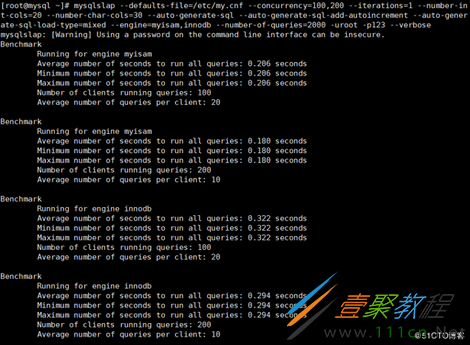MySQL之压力测试工具如何使用 MySQL之压力测试工具使用方法
MySQL之压力测试工具如何使用?本篇文章小编给大家分享一下MySQL之压力测试工具使用方法,小编觉得挺不错的,现在分享给大家供大家参考,有需要的小伙伴们可以来看看。
一、MySQL自带的压力测试工具——Mysqlslap
mysqlslap是mysql自带的基准测试工具,该工具查询数据,语法简单,灵活容易使用.该工具可以模拟多个客户端同时并发的向服务器发出查询更新,给出了性能测试数据而且提供了多种引擎的性能比较。mysqlslap为mysql性能优化前后提供了直观的验证依据,系统运维和DBA人员应该掌握一些常见的压力测试工具,才能准确的掌握线上数据库支撑的用户流量上限及其抗压性等问题。
1、更改其默认的最大连接数
在对MySQL进行压力测试之前,需要更改其默认的最大连接数,如下:
[root@mysql ~]# vim /etc/my.cnf ................ [mysqld] max_connections=1024 [root@mysql ~]# systemctl restart mysqld
#查看最大连接数 mysql> show variables like 'max_connections'; +-----------------+-------+ | Variable_name | Value | +-----------------+-------+ | max_connections | 1024 | +-----------------+-------+ 1 row in set (0.00 sec)
进行压力测试:
[root@mysql ~]# mysqlslap --defaults-file=/etc/my.cnf --concurrency=100,200 --iterations=1 --number-int-cols=20 --number-char-cols=30 --auto-generate-sql --auto-generate-sql-add-autoincrement --auto-generate-sql-load-type=mixed --engine=myisam,innodb --number-of-queries=2000 -uroot -p123 --verbose
上述命令测试说明:模拟测试两次读写并发,第一次100,第二次200,自动生成SQL脚本,测试表包含20个init字段,30
个char字段,每次执行2000查询请求。测试引擎分别是myisam,innodb。(上述选项中有很多都是默认值,可以省略,如果想要了解各个选项的解释,可以使用mysqlslap
--help进行查询)
上述命令返回结果如下:
测试结果说明: Myisam第一次100客户端同时发起增查用0.557/s,第二次200客户端同时发起增查用0.522/s Innodb第一次100客户端同时发起增查用0.256/s,第二次200客户端同时发起增查用0.303/s 。
可以根据实际需求,一点点的加大并发数量进行压力测试。
二、使用第三方sysbench工具进行压力测试
1、安装sysbench工具
[root@mysql ~]# yum -y install epel-release #安装第三方epel源 [root@mysql ~]# yum -y install sysbench #安装sysbench工具 [root@mysql ~]# sysbench --version #确定工具已安装 sysbench 1.0.17
sysbench 可以进行以下测试:
CPU 运算性能测试
磁盘 IO 性能测试
调度程序性能测试
内存分配及传输速度测试
POSIX 线程性能测试
数据库性能测试(OLTP 基准测试,需要通过 /usr/share/sysbench/ 目录中的 Lua 脚本执行,例如 oltp_read_only.lua 脚本执行只读测试)
sysbench 还可以通过运行命令时指定自己的 Lua 脚本来自定义测试。
2、查看sysbench工具的帮助选项
[root@mysql ~]# sysbench --help
Usage:
sysbench [options]... [testname] [command]
Commands implemented by most tests: prepare run cleanup help # 可用的命令,四个
General options: # 通用选项
--threads=N 要使用的线程数,默认 1 个 [1]
--events=N 最大允许的事件个数 [0]
--time=N 最大的总执行时间,以秒为单位 [10]
--forced-shutdown=STRING 在 --time 时间限制到达后,强制关闭之前等待的秒数,默认“off”禁用(number of seconds to wait after the --time limit before forcing shutdown, or 'off' to disable) [off]
--thread-stack-size=SIZE 每个线程的堆栈大小 [64K]
--rate=N 平均传输速率。0 则无限制 [0]
--report-interval=N 以秒为单位定期报告具有指定间隔的中间统计信息 0 禁用中间报告 [0]
--report-checkpoints=[LIST,...] 转储完整的统计信息并在指定的时间点重置所有计数器。参数是一个逗号分隔的值列表,表示从测试开始经过这个时间量时必须执行报告检查点(以秒为单位)。报告检查点默认关闭。 []
--debug[=on|off] 打印更多 debug 信息 [off]
--validate[=on|off] 尽可能执行验证检查 [off]
--help[=on|off] 显示帮助信息并退出 [off]
--version[=on|off] 显示版本信息并退出 [off]
--config-file=FILENAME 包含命令行选项的文件
--tx-rate=N 废弃,改用 --rate [0]
--max-requests=N 废弃,改用 --events [0]
--max-time=N 废弃,改用 --time [0]
--num-threads=N 废弃,改用 --threads [1]
Pseudo-Random Numbers Generator options: # 伪随机数发生器选项
--rand-type=STRING random numbers distribution {uniform,gaussian,special,pareto} [special]
--rand-spec-iter=N number of iterations used for numbers generation [12]
--rand-spec-pct=N percentage of values to be treated as 'special' (for special distribution) [1]
--rand-spec-res=N percentage of 'special' values to use (for special distribution) [75]
--rand-seed=N seed for random number generator. When 0, the current time is used as a RNG seed. [0]
--rand-pareto-h=N parameter h for pareto distribution [0.2]
Log options: # 日志选项
--verbosity=N verbosity level {5 - debug, 0 - only critical messages} [3]
--percentile=N percentile to calculate in latency statistics (1-100). Use the special value of 0 to disable percentile calculations [95]
--histogram[=on|off] print latency histogram in report [off]
General database options: # 通用的数据库选项
--db-driver=STRING 指定要使用的数据库驱动程序 ('help' to get list of available drivers)
--db-ps-mode=STRING prepared statements usage mode {auto, disable} [auto]
--db-debug[=on|off] print database-specific debug information [off]
Compiled-in database drivers: # 內建的数据库驱动程序,默认支持 MySQL 和 PostgreSQL
mysql - MySQL driver
pgsql - PostgreSQL driver
mysql options: # MySQL 数据库专用选项
--mysql-host=[LIST,...] MySQL server host [localhost]
--mysql-port=[LIST,...] MySQL server port [3306]
--mysql-socket=[LIST,...] MySQL socket
--mysql-user=STRING MySQL user [sbtest]
--mysql-password=STRING MySQL password []
--mysql-db=STRING MySQL database name [sbtest]
--mysql-ssl[=on|off] use SSL connections, if available in the client library [off]
--mysql-ssl-cipher=STRING use specific cipher for SSL connections []
--mysql-compression[=on|off] use compression, if available in the client library [off]
--mysql-debug[=on|off] trace all client library calls [off]
--mysql-ignore-errors=[LIST,...] list of errors to ignore, or "all" [1213,1020,1205]
--mysql-dry-run[=on|off] Dry run, pretend that all MySQL client API calls are successful without executing them [off]
pgsql options: # PostgreSQL 数据库专用选项
--pgsql-host=STRING PostgreSQL server host [localhost]
--pgsql-port=N PostgreSQL server port [5432]
--pgsql-user=STRING PostgreSQL user [sbtest]
--pgsql-password=STRING PostgreSQL password []
--pgsql-db=STRING PostgreSQL database name [sbtest]
Compiled-in tests: # 內建测试类型
fileio - File I/O test
cpu - CPU performance test
memory - Memory functions speed test
threads - Threads subsystem performance test
mutex - Mutex performance test
See 'sysbench help' for a list of options for each test.
3、sysbench测试MySQL数据库性能
1)准备测试数据
#查看sysbench自带的lua脚本使用方法 [root@mysql ~]# sysbench /usr/share/sysbench/oltp_common.lua help #必须创建sbtest库,sbtest事sysbench默认使用的库名 [root@mysql ~]# mysqladmin -uroot -p123 create sbtest; #然后,准备测试所用的表,这些测试表放在测试库sbtest中。这里使用的lua脚本为/usr/share/sysbench/oltp_common.lua [root@mysql ~]# sysbench --mysql-host=127.0.0.1 > --mysql-port=3306 > --mysql-user=root > --mysql-password=123 > /usr/share/sysbench/oltp_common.lua > --tables=10 > --table_size=100000 > prepare #其中--tables=10表示创建10个测试表, #--table_size=100000表示每个表中插入10W行数据, #prepare表示这是准备数的过程。
2)确认测试数据以存在
[root@mysql ~]# mysql -uroot -p123 sbtest; #登录到sbtest库 mysql> show tables; #查看相应的表 +------------------+ | Tables_in_sbtest | +------------------+ | sbtest1 | | sbtest10 | | sbtest2 | | sbtest3 | | sbtest4 | | sbtest5 | | sbtest6 | | sbtest7 | | sbtest8 | | sbtest9 | +------------------+ 10 rows in set (0.00 sec) mysql> select count(*) from sbtest1; #随机选择一个表,确认其有100000条数据 +----------+ | count(*) | +----------+ | 100000 | +----------+ 1 row in set (0.01 sec)
3)数据库测试和结果分析
稍微修改下之前准备数据的语句,就可以拿来测试了。
需要注意的是,之前使用的lua脚本为oltp_common.lua,它是一个通用脚本,是被其它lua脚本调用的,它不能直接拿来测试。
所以,我这里用oltp_read_write.lua脚本来做读、写测试。还有很多其它类型的测试,比如只读测试、只写测试、删除测试、大批量插入测试等等。可找到对应的lua脚本进行调用即可。
#执行测试命令如下: [root@mysql ~]# sysbench --threads=4 > --time=20 > --report-interval=5 > --mysql-host=127.0.0.1 > --mysql-port=3306 > --mysql-user=root > --mysql-password=123 > /usr/share/sysbench/oltp_read_write.lua > --tables=10 > --table_size=100000 > run
上述命令返回的结果如下:
[root@mysql ~]# sysbench --threads=4 --time=20 --report-interval=5 --mysql-host=127.0.0.1 --mysql-port=3306 --mysql-user=root --mysql-password=123 /usr/share/sysbench/oltp_read_write.lua --tables=10 --table_size=100000 run
sysbench 1.0.17 (using system LuaJIT 2.0.4)
Running the test with following options:
Number of threads: 4
Report intermediate results every 5 second(s)
Initializing random number generator from current time
Initializing worker threads...
Threads started!
#以下是每5秒返回一次的结果,统计的指标包括:
# 线程数、tps(每秒事务数)、qps(每秒查询数)、
# 每秒的读/写/其它次数、延迟、每秒错误数、每秒重连次数
[ 5s ] thds: 4 tps: 1040.21 qps: 20815.65 (r/w/o: 14573.17/4161.25/2081.22) lat (ms,95%): 7.17 err/s: 0.00 reconn/s: 0.00
[ 10s ] thds: 4 tps: 1083.34 qps: 21667.15 (r/w/o: 15165.93/4334.55/2166.68) lat (ms,95%): 6.55 err/s: 0.00 reconn/s: 0.00
[ 15s ] thds: 4 tps: 1121.57 qps: 22429.09 (r/w/o: 15700.64/4485.30/2243.15) lat (ms,95%): 6.55 err/s: 0.00 reconn/s: 0.00
[ 20s ] thds: 4 tps: 1141.69 qps: 22831.98 (r/w/o: 15982.65/4566.16/2283.18) lat (ms,95%): 6.09 err/s: 0.00 reconn/s: 0.00
SQL statistics:
queries performed:
read: 307146 # 执行的读操作数量
write: 87756 # 执行的写操作数量
other: 43878 # 执行的其它操作数量
total: 438780
transactions: 21939 (1096.57 per sec.) # 执行事务的平均速率
queries: 438780 (21931.37 per sec.) # 平均每秒能执行多少次查询
ignored errors: 0 (0.00 per sec.)
reconnects: 0 (0.00 per sec.)
General statistics:
total time: 20.0055s # 总消耗时间
total number of events: 21939 # 总请求数量(读、写、其它)
Latency (ms):
min: 1.39
avg: 3.64
max: 192.05
95th percentile: 6.67 # 采样计算的平均延迟
sum: 79964.26
Threads fairness:
events (avg/stddev): 5484.7500/15.12
execution time (avg/stddev): 19.9911/0.00
4、cpu/io/内存等测试
sysbench内置的几个测试指标如下:
[root@mysql ~]# sysbench --help .......... # 省略部分内容 Compiled-in tests: fileio - File I/O test cpu - CPU performance test memory - Memory functions speed test threads - Threads subsystem performance test mutex - Mutex performance test
可以直接help输出测试方法,例如,fileio测试:
[root@mysql ~]# sysbench fileio help
sysbench 1.0.17 (using system LuaJIT 2.0.4)
fileio options:
--file-num=N number of files to create [128]
--file-block-size=N block size to use in all IO operations [16384]
--file-total-size=SIZE total size of files to create [2G]
--file-test-mode=STRING test mode {seqwr, seqrewr, seqrd, rndrd, rndwr, rndrw}
--file-io-mode=STRING file operations mode {sync,async,mmap} [sync]
--file-async-backlog=N number of asynchronous operatons to queue per thread [128]
--file-extra-flags=[LIST,...] list of additional flags to use to open files {sync,dsync,direct} []
--file-fsync-freq=N do fsync() after this number of requests (0 - don't use fsync()) [100]
--file-fsync-all[=on|off] do fsync() after each write operation [off]
--file-fsync-end[=on|off] do fsync() at the end of test [on]
--file-fsync-mode=STRING which method to use for synchronization {fsync, fdatasync} [fsync]
--file-merged-requests=N merge at most this number of IO requests if possible (0 - don't merge) [0]
--file-rw-ratio=N reads/writes ratio for combined test [1.5]
1)测试io性能
例如,创建5个文件,总共2G,每个文件大概400M。
[root@mysql ~]# sysbench fileio --file-num=5 --file-total-size=2G prepare [root@mysql ~]# ll -lh test* -rw------- 1 root root 410M May 26 16:05 test_file.0 -rw------- 1 root root 410M May 26 16:05 test_file.1 -rw------- 1 root root 410M May 26 16:05 test_file.2 -rw------- 1 root root 410M May 26 16:05 test_file.3 -rw------- 1 root root 410M May 26 16:05 test_file.4
然后运行测试:
[root@mysql ~]# sysbench --events=5000 > --threads=16 > fileio > --file-num=5 > --file-total-size=2G > --file-test-mode=rndrw > --file-fsync-freq=0 > --file-block-size=16384 > run
返回的结果如下:
Running the test with following options:
Number of threads: 16
Initializing random number generator from current time
Extra file open flags: (none)
5 files, 409.6MiB each
2GiB total file size
Block size 16KiB
Number of IO requests: 5000
Read/Write ratio for combined random IO test: 1.50
Calling fsync() at the end of test, Enabled.
Using synchronous I/O mode
Doing random r/w test
Initializing worker threads...
Threads started!
File operations:
reads/s: 9899.03
writes/s: 6621.38
fsyncs/s: 264.33
Throughput: # 吞吐量
read, MiB/s: 154.66 #表示读带宽
written, MiB/s: 103.46 #表示写的带宽
General statistics:
total time: 0.3014s
total number of events: 5000
Latency (ms):
min: 0.00
avg: 0.81
max: 53.56
95th percentile: 4.10
sum: 4030.48
Threads fairness:
events (avg/stddev): 312.5000/27.64
execution time (avg/stddev): 0.2519/0.02
2)测试cpu性能
[root@mysql ~]# sysbench cpu --threads=40 --events=10000 --cpu-max-prime=20000 run
相关文章
精彩推荐
-
 下载
下载疯狂医院达什医生中文版(Crazy Hospital)
模拟经营 疯狂医院达什医生中文版(Crazy Hospital)疯狂医院达什医生最新版是一款医院模拟经营类游戏,逼真的场景画
-
 下载
下载宝宝庄园官方版
模拟经营 宝宝庄园官方版宝宝庄园官方版是一款超级经典好玩的模拟经营类型的手游,这个游
-
 下载
下载桃源记官方正版
模拟经营 桃源记官方正版桃源记是一款休闲娱乐类的水墨手绘风格打造的模拟经营手游。玩家
-
 下载
下载长途巴士模拟器手机版
模拟经营 长途巴士模拟器手机版长途巴士模拟器汉化版是一款十分比真好玩的大巴车模拟驾驶运营类
-
 下载
下载房东模拟器最新版2024
模拟经营 房东模拟器最新版2024房东模拟器中文版是一个超级有趣的模拟经营类型的手游,这个游戏
















